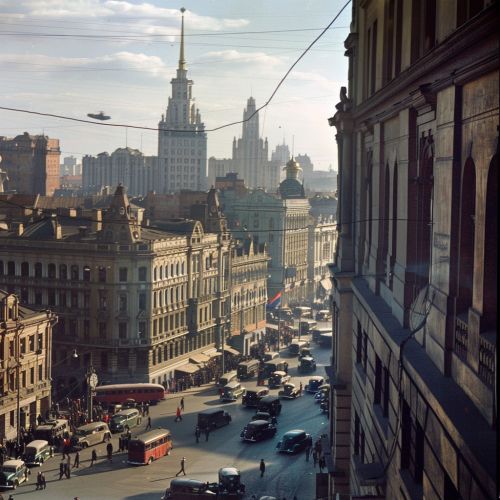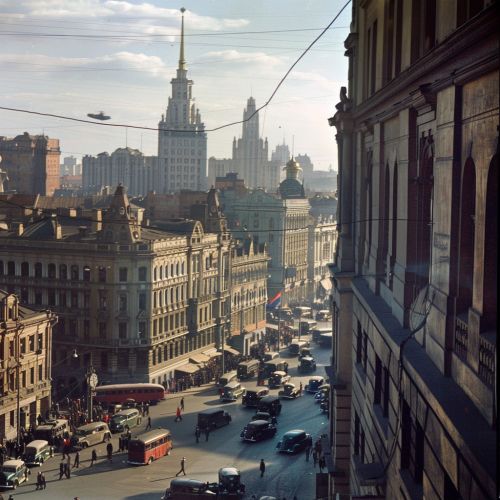Moscow in 1945
Historical Context
In 1945, Moscow was the capital of the Soviet Union and a focal point of significant historical events. The city had endured the hardships of World War II, known in Russia as the Great Patriotic War, which lasted from 1941 to 1945. By the end of the war, Moscow emerged not only as a symbol of Soviet resilience but also as a center of post-war reconstruction and political activity.
Political Landscape
The political landscape of Moscow in 1945 was dominated by the Communist Party, led by Joseph Stalin. Stalin's leadership was characterized by a combination of totalitarian control and efforts to rebuild the nation. The NKVD, the Soviet secret police, played a crucial role in maintaining internal security and suppressing dissent.
Government and Administration
Moscow's administration was tightly controlled by the central government. The Moscow City Soviet, the local governing body, was responsible for implementing policies dictated by the central authorities. The city's governance was marked by a hierarchical structure that ensured strict adherence to the Communist Party's directives.
Economic Conditions
The economy of Moscow in 1945 was in a state of transition from wartime production to peacetime reconstruction. The war had devastated much of the Soviet Union's infrastructure, and Moscow was no exception. However, the city was relatively better off compared to other regions due to its strategic importance.
Industrial Sector
Moscow's industrial sector was a critical component of the Soviet economy. Factories that had been repurposed for wartime production were gradually shifting back to civilian manufacturing. Key industries included machinery, textiles, and chemicals. The Moscow Metro, an essential part of the city's infrastructure, also saw expansion efforts during this period.
Agricultural Sector
While Moscow itself was not a major agricultural center, it relied heavily on surrounding regions for food supplies. The collectivization policies of the 1930s had left a lasting impact on agricultural productivity. In 1945, efforts were underway to restore agricultural output to pre-war levels.
Social Conditions
The social fabric of Moscow in 1945 was shaped by the aftermath of the war. The population had endured significant hardships, including food shortages, bombings, and the loss of loved ones. Despite these challenges, there was a sense of resilience and determination to rebuild.
Demographics
The population of Moscow in 1945 was diverse, comprising various ethnic groups from across the Soviet Union. The war had led to significant demographic shifts, with many people migrating to the city in search of work and better living conditions. The city's population was also affected by the return of soldiers from the front lines.
Housing and Living Conditions
Housing was a critical issue in post-war Moscow. Many buildings had been damaged or destroyed during the war, leading to severe housing shortages. The government initiated large-scale construction projects to address this problem, but living conditions remained challenging for many residents.


Cultural Life
Despite the hardships, cultural life in Moscow continued to thrive. The city was home to numerous theaters, museums, and educational institutions that played a vital role in maintaining the cultural heritage of the Soviet Union.
The Arts
The arts were heavily influenced by the state's ideology. Socialist realism was the dominant artistic style, emphasizing themes of heroism, labor, and the glorification of the Soviet state. The Bolshoi Theatre remained a prominent cultural institution, showcasing ballet and opera performances that adhered to these themes.
Education
Education was a priority for the Soviet government, and Moscow was home to some of the country's most prestigious institutions. The Moscow State University was a leading center of higher education and research. Efforts were made to expand educational opportunities to all citizens, reflecting the state's commitment to literacy and scientific advancement.
International Relations
In 1945, Moscow was at the center of global diplomatic activity. The end of World War II marked the beginning of the Cold War, a period of geopolitical tension between the Soviet Union and the Western powers, particularly the United States.
Diplomacy
Moscow hosted numerous diplomatic missions and was a key player in the formation of the United Nations. The city's diplomats were involved in negotiations that shaped the post-war world order. The Yalta Conference, held earlier in 1945, had significant implications for Moscow's role in international affairs.
Military Presence
The Soviet military presence in Moscow was substantial. The city was home to several key military installations and served as the headquarters for the Red Army. The Victory Parade of 1945, held on June 24th, was a significant event that showcased the military might of the Soviet Union and celebrated the defeat of Nazi Germany.
Reconstruction and Development
Reconstruction efforts in Moscow were ambitious and multifaceted. The government launched several initiatives to rebuild the city's infrastructure and improve living conditions for its residents.
Infrastructure Projects
Major infrastructure projects included the expansion of the Moscow Metro, the construction of new housing complexes, and the repair of war-damaged buildings. These projects were part of a broader effort to modernize the city and improve its functionality.
Economic Policies
The Soviet government implemented various economic policies to facilitate reconstruction. These included state planning, resource allocation, and labor mobilization. The Gosplan, the State Planning Committee, played a crucial role in directing these efforts.
Conclusion
Moscow in 1945 was a city in transition, emerging from the devastation of war and embarking on a path of reconstruction and development. The political, economic, and social conditions of the time were shaped by the broader context of the Soviet Union's efforts to rebuild and assert its influence on the global stage. Despite the challenges, the resilience and determination of Moscow's residents played a crucial role in the city's recovery and growth.
